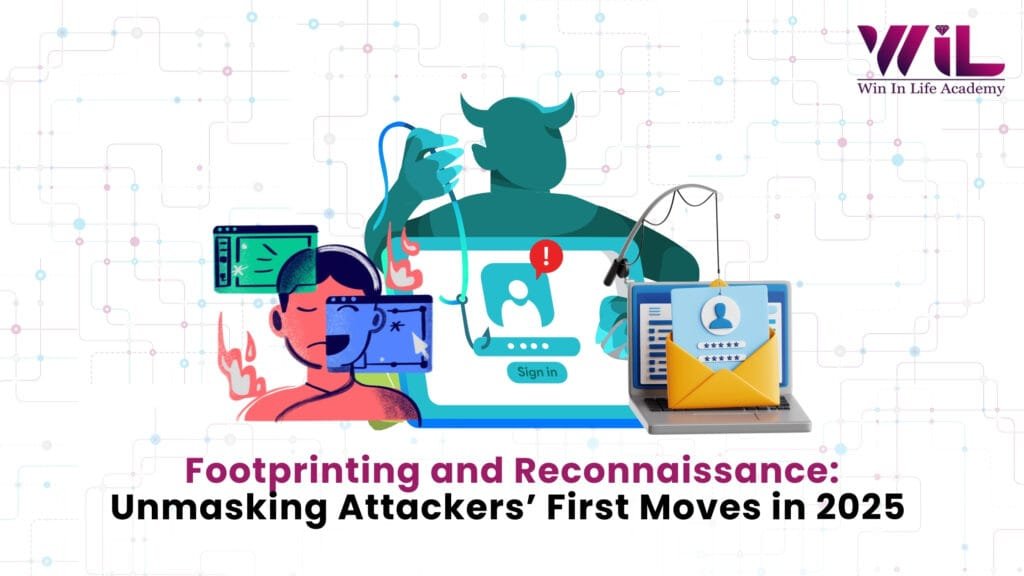Introduction
In the current day and era, understanding the methods used by cyber attackers is crucial for safeguarding sensitive data and preventing unauthorized access. Footprinting and reconnaissance are two fundamental steps in any cyberattack. These pre-attack procedures involve collecting information about a target system or network to identify vulnerabilities and potential entry points.
With the rise in cyberattacks, mastering footprinting through social engineering and footprinting using advanced google hacking techniques is essential. Attackers exploit publicly available data, social media data, and search engines to uncover vulnerabilities. Learning these techniques helps security professionals detect threats before they escalate. By gaining a deep understanding of the techniques behind reconnaissance and footprinting, organizations can enhance their defensive strategies and bolster their cybersecurity posture. Stay ahead of cybercriminals by enrolling in Win In Life Academy’s Ethical Hacking Course and strengthen your defenses today!
In this blog, we will explore the various types of footprinting, its role, and advanced techniques to prevent it. Specifically, we will delve into advanced google hacking techniques, footprinting through people Search services, footprinting through social networking site as key footprinting methods.
Understanding Footprinting
Footprinting, refers to the process of gathering information about computer systems and the organizations they belong to. Hackers utilize various tools and technologies to collect this data, which aids them in devising an attack strategy. Footprinting is an essential pre-attack phase, helping attackers analyze the security measures of their targets.
Enrol now: Certified Ethical Hacker Course
Types of Footprinting
Footprinting can be categorized into two types:
1. Active Footprinting
Active footprinting involves directly interacting with the target system to gather information. This method is riskier as it may trigger security alerts, making the attacker’s presence detectable. Examples of active footprinting include:
- Using tools like Nmap to scan the target’s open ports
- Sending phishing emails to gain unauthorized information
2. Passive Footprinting
Passive footprinting involves collecting information about a target without directly interacting with it. This method is harder to detect and typically relies on publicly available sources. Examples include:
- Searching social media platforms for employee information
- Examining domain registration details using Whois lookups
How is Footprinting Carried Out?

Several methods are used for footprinting, each providing different insights into the target system’s security posture.
1. Open-Source Intelligence (OSINT)
OSINT involves gathering information from publicly available sources such as:
- Websites
- Blogs
- News articles
- Social media platforms
Read the blog on The Art of Deception: Unmasking Social Engineering in Cybersecurity 2025
2. Network Scanning
Network scanning identifies active network devices, their IP addresses, and open ports. This helps attackers understand the structure of the target system.
3. DNS Enumeration
DNS enumeration is used to collect information about a target’s domain, including subdomains and associated IP addresses.
4. Whois Lookups
Whois lookups reveal domain ownership, tenure domain name and registration details, offering valuable insights into the organization’s infrastructure.
Footprinting through Social Engineering
Social engineering is a psychological manipulation technique used to deceive individuals into revealing sensitive information. Common social engineering tactics include:
- Eavesdropping: Listening to private conversations to gather confidential information.
- Shoulder Surfing: Observing someone entering credentials or confidential data.
- Phishing: Sending fraudulent emails that trick recipients into providing personal information.
Enrol now: Certified Ethical Hacker Course
Footprinting Using Advanced Google Hacking Techniques

Attackers use advanced Google search operators to find exposed sensitive information. Some commonly used search operators include:
- inurl: – Finds URLs, which contain specific words.
- filetype: – Searches for specific file types such as filetype: pdf for PDFs.
- intitle: – which searches for specific words in page titles.
For example, searching inurl:”ViewerFrame?Mode=” can reveal public web cameras accessible over the internet.
Footprinting through People Search Services
People search services help attackers gather personal information about employees within an organization. Some commonly used platforms include:
- Online directories
- Background check websites
- Social networking platforms
By leveraging these services, attackers can uncover email addresses, phone numbers, and even employment history, aiding their reconnaissance efforts.
Footprinting through Social Networking Sites
Social media platforms are a goldmine for hackers looking to gather information about an organization or individuals.
Attackers may:
- Create fake profiles to befriend employees
- Monitor job postings for technology and security-related insights
- Extract data from employee profiles, such as job roles, email addresses, and project details
Organizations must educate employees on the risks of sharing too much information on social media.
Enroll now: Cybersecurity Courses
Advantages of Footprinting
Footprinting allows attackers to:
- Understand a company’s security measures.
- Identify vulnerabilities and potential entry points.
- Reduce the attack surface by focusing on specific systems.
- Map network topology, including trusted routers and firewalls.
While these advantages benefit attackers, security professionals can use the same techniques for defensive purposes.
Understanding Reconnaissance
Reconnaissance is a broader term that encompasses all activities aimed at gathering intelligence on a target system. It involves more intrusive techniques compared to footprinting.
How is Reconnaissance Carried Out?
Common reconnaissance techniques include:
1. Port Scanning: Port scanning identifies open ports and services on a target system, helping attackers determine potential vulnerabilities.
2. Vulnerability Scanning: This technique involves scanning systems for known vulnerabilities that could be exploited.
3. Packet Sniffing: Packet sniffing captures network traffic to analyze data packets and uncover sensitive information.
4. Social Engineering: Attackers use social engineering tactics to manipulate employees into revealing confidential data or granting unauthorized access.
The Key Differences Between Footprinting and Reconnaissance

While both techniques involve gathering information, they differ in key aspects:
| Feature | Footprinting | Reconnaissance |
| Methodology | Passive, non-intrusive | Active probing and scanning |
| Objective | Understanding infrastructure and vulnerabilities | Exploiting weaknesses to gain unauthorized access |
| Risk Level | Lower risk | Higher risk, leaves traces |
| Legal Considerations | Often legal | Can breach legal boundaries |
Preventing Footprinting and Reconnaissance
Organizations can take several preventive measures to reduce their exposure to footprinting and reconnaissance. Following are the steps to prevent footprinting and reconnaissance:
- Limiting Information Exposure: Minimize the amount of sensitive information available online.
- Securing DNS Records: Configure DNS settings to prevent unauthorized access.
- Implementing Access Controls: Restrict access to sensitive systems.
- Employee Training: Educate staff on social engineering risks and best cybersecurity practices.
- Regular Vulnerability Assessments: Identify and mitigate security flaws proactively.
- Monitoring Online Presence: Keep track of data leaks on public platforms.
- Applying Security Patches: Regularly update software and hardware.
- Network Segmentation: Divide networks to limit unauthorized access.
- Incident Response Planning: Establish protocols to respond to cyber threats effectively.
Conclusion
Footprinting and reconnaissance play a crucial role in understanding an organization’s security posture and identifying potential vulnerabilities. Footprinting involves gathering information passively, while reconnaissance includes more active probing techniques. By staying informed and implementing strong security measures, organizations can protect themselves from cyber threats.
For those looking to deepen their knowledge in cybersecurity, Win In Life Academy’s Ethical Hacking Training Course offers in-depth insights into footprinting and reconnaissance, session hijacking, and other critical cybersecurity techniques. Enrol today and strengthen your cybersecurity skills!
Frequently Asked Questions:
What is the difference between footprinting and reconnaissance?
Footprinting through People Search Services involves gathering information about a target system, while reconnaissance is the broader process of information gathering in ethical hacking. By conducting thorough reconnaissance footprinting, security professionals can assess risks, strengthen defences, and prevent potential cyber threats.
What is footprinting in cyber security?
In cybersecurity, footprinting is the process of gathering information about a target organization, its network, and systems to identify potential vulnerabilities, often done before a real attack or penetration test.
What is an example of footprinting through Social Networking Site?
Active footprinting through social networking sites might consist of sending a phishing email to an employee in an attempt to collect personal and professional information. Passive footprinting could be as simple as reading a company’s website or googling them to see what information is available about them.
What are the two reconnaissance techniques?
There are two main types of reconnaissance: active and passive reconnaissance.
Why is footprinting and reconnaissance important in cyber security
Footprinting and reconnaissance are crucial in cybersecurity because they enable the gathering of information about a target, revealing potential vulnerabilities and weaknesses, which allows for proactive defense and better security planning.
Reference:
- https://www.eccouncil.org/cybersecurity-exchange/ethical-hacking/basics-footprinting-reconnaissance/





